Related Research Articles
The Internet Protocol (IP) is the principal communications protocol in the Internet protocol suite for relaying datagrams across network boundaries. Its routing function enables internetworking, and essentially establishes the Internet.

Electric power transmission is the bulk movement of electrical energy from a generating site, such as a power plant, to an electrical substation. The interconnected lines which facilitate this movement are known as a transmission network. This is distinct from the local wiring between high-voltage substations and customers, which is typically referred to as electric power distribution. The combined transmission and distribution network is part of electricity delivery, known as the "power grid" in North America, or just "the grid". In the United Kingdom, India, Tanzania, Myanmar, Malaysia and New Zealand, the network is known as the National Grid.
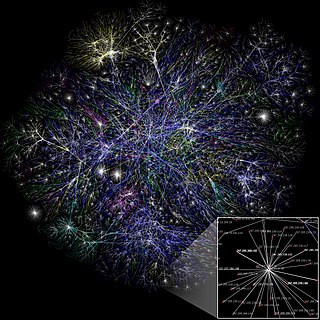
Network topology is the arrangement of the elements of a communication network. Network topology can be used to define or describe the arrangement of various types of telecommunication networks, including command and control radio networks, industrial fieldbusses and computer networks.
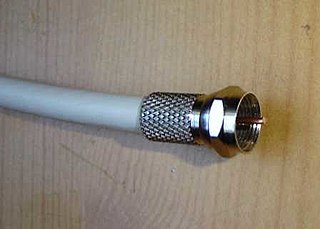
In radio-frequency engineering, a transmission line is a specialized cable or other structure designed to conduct alternating current of radio frequency, that is, currents with a frequency high enough that their wave nature must be taken into account. Transmission lines are used for purposes such as connecting radio transmitters and receivers with their antennas, distributing cable television signals, trunklines routing calls between telephone switching centres, computer network connections and high speed computer data buses.

A transmission medium is something that can mediate the propagation of signals for the purposes of telecommunication.
Data transmission is the transfer of data over a point-to-point or point-to-multipoint communication channel. Examples of such channels are copper wires, optical fibers, wireless communication channels, storage media and computer buses. The data are represented as an electromagnetic signal, such as an electrical voltage, radiowave, microwave, or infrared signal.

An epidemic is the rapid spread of infectious disease to a large number of people in a given population within a short period of time, usually two weeks or less. For example, in meningococcal infections, an attack rate in excess of 15 cases per 100,000 people for two consecutive weeks is considered an epidemic.
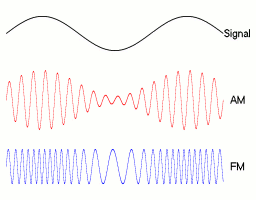
AM broadcasting is a radio broadcasting technology, which employs amplitude modulation (AM) transmissions. It was the first method developed for making audio radio transmissions, and is still used worldwide, primarily for medium wave transmissions, but also on the longwave and shortwave radio bands.

A substation is a part of an electrical generation, transmission, and distribution system. Substations transform voltage from high to low, or the reverse, or perform any of several other important functions. Between the generating station and consumer, electric power may flow through several substations at different voltage levels. A substation may include transformers to change voltage levels between high transmission voltages and lower distribution voltages, or at the interconnection of two different transmission voltages.
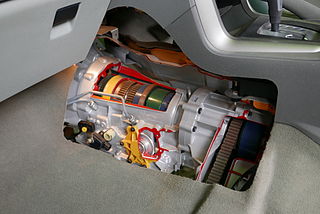
An automatic transmission, also called auto, self-shifting transmission, n-speed automatic, or AT, is a type of motor vehicle transmission that can automatically change gear ratios as the vehicle moves, freeing the driver from having to shift gears manually. Like other transmission systems on vehicles, it allows an internal combustion engine, best suited to run at a relatively high rotational speed, to provide a range of speed and torque outputs necessary for vehicular travel. The number of forward gear ratios is often expressed for manual transmissions as well.

A transmission is a machine in a power transmission system, which provides controlled application of the power. Often the term transmission refers simply to the gearbox that uses gears and gear trains to provide speed and torque conversions from a rotating power source to another device.
A continuously variable transmission (CVT), also known as a shiftless transmission, stepless transmission, pulley transmission, or, in case of motorcycles, a 'twist-and-go', is an automatic transmission that can change seamlessly through a continuous range of effective gear ratios. This contrasts with other mechanical transmissions that offer a fixed number of gear ratios. The flexibility of a CVT with suitable control may allow the input shaft to maintain a constant angular velocity even as the output speed varies.

A manual transmission, also known as a manual gearbox, a standard transmission or colloquially in some countries as a stick shift, is a type of transmission used in motor vehicle applications. It uses a driver-operated clutch, usually engaged and disengaged by a foot pedal or hand lever, for regulating torque transfer from the engine to the transmission; and a gear selector that can be operated by hand.
In medicine, public health, and biology, transmission is the passing of a pathogen causing communicable disease from an infected host individual or group to a particular individual or group, regardless of whether the other individual was previously infected.
A semi-automatic transmission (SAT) is an automated automobile transmission that combines manual transmission and automatic transmission. An Automated manual transmission can simply and best be described as a standard manual transmission, with an automated clutch, and automated clutch and gear shift control.
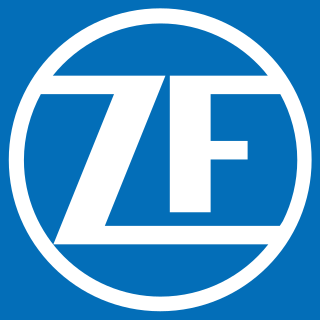
ZF Friedrichshafen AG, also known as ZF Group, originally Zahnradfabrik Friedrichshafen, and commonly abbreviated to ZF, is a German car parts maker headquartered in Friedrichshafen, in the south-west German region of Baden-Württemberg.
BorgWarner Inc. is an American worldwide automotive industry components and parts supplier. It is primarily known for its powertrain products, which include manual and automatic transmissions and transmission components such as electro-hydraulic control components, transmission control units, friction materials, and one-way clutches, turbochargers, engine valve timing system components, along with four-wheel drive system components.
Transmission is a BitTorrent client which features a variety of user interfaces on top of a cross-platform back-end. Transmission is free software licensed under the terms of the GNU General Public License, with parts under the MIT License.

Human immunodeficiency virus infection and acquired immune deficiency syndrome (HIV/AIDS) is a spectrum of conditions caused by infection with the human immunodeficiency virus (HIV). Following initial infection a person may not notice any symptoms, or may experience a brief period of influenza-like illness. Typically, this is followed by a prolonged period with no symptoms. If the infection progresses, it interferes more with the immune system, increasing the risk of developing common infections such as tuberculosis, as well as other opportunistic infections, and tumors which are otherwise rare in people who have normal immune function. These late symptoms of infection are referred to as acquired immunodeficiency syndrome (AIDS). This stage is often also associated with unintended weight loss.

A dual-clutch transmission (DCT) is an automated manual transmission in automobiles, closely related to a manual transmission. It uses two separate clutches for odd and even gear sets. It can fundamentally be described as two separate manual transmissions with their respective clutches contained within one housing, and working as one unit. Although usually operated in a fully automatic mode, many also have the ability to allow the driver to manually shift gears in semi-automatic mode, albeit still using the transmission's electrohydraulics.
References
- ↑ "Volume 5". System Control Centre Modernization Project. Ceylon Electricity Board. Retrieved 10 December 2012.[ permanent dead link ]
| This Sri Lanka-related article is a stub. You can help Wikipedia by expanding it. |
| This article about energy, its collection, its distribution, or its uses is a stub. You can help Wikipedia by expanding it. |